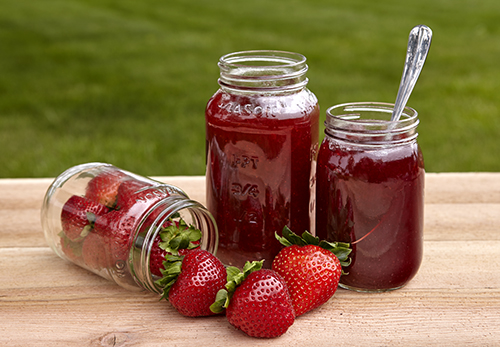Jelly, Jam and Preserves
Admittedly, I’ve spent most of my life not knowing the difference between jelly, jam and preserves. It was only recently that I found out the difference.
Jelly shakes and jam doesn’t, right? Some of you might remember that song by the Glenn Miller Orchestra, “It Must Be Jelly (‘Cause Jam Don’t Shake Like That).” Well, there’s actually a scientific way to tell the difference between these very similar approaches to preserving fruit.
Jelly, jam and preserves are all made from fruit mixes with sugar and pectin (an indigestible carbohydrate found in the cell walls of most fruit). The difference between them comes in the form that the fruit takes.

Jelly
In jelly, the fruit comes in the form of fruit juice. With the smoothest consistency, jelly is made by crushing a fruit and discarding the solid, chunky portions, leaving only the fruit juice. The fruit juice is then mixed with pectin and heated to form a gelatinous spread.
As I mentioned, jelly is firm and will hold its shape, and can be identified by “shaking.” Typically, jelly doesn’t contain pieces of fruit, although some spicy jellies may include pieces of jalapeño or chile peppers. And, for wine lovers, a good wine jelly is made with a concentration of real wine. In fact, the better the wine and the more wine in the jelly, the better the wine jelly. If you’ve ever had a good wine jelly, you won’t forget it. A high-end wine jelly tastes just like a glass of wine.
Jam
Jam is similarly made by crushing a fruit and cooking it with sugar, and sometimes pectin and lemon juice. During this process, many solid pieces of the fruit’s fibers are left in the mixture to give it a more spreadable consistency. Jam contains a rich portion of fruitiness, and is most often used to complement cheeses and crackers. Jam can be a purée of fruit or have a soft pulp, but it does not contain chunks of fruit.
Preserves
In preserves, the fruit comes in the form of chunks in a syrup or a jam. A preserve differs from jam in that large or whole pieces of fruit are cooked with sugar to the point where the fruit is suspended in a syrup base. The texture of preserves is not smooth like jelly or jam. Preserves are often used for cooking and baking, as they contain the largest amount of the fruit’s flavor in a mixable form. Of the three, preserves use the most fruit. With preserves, the fruit is chopped into smaller pieces that are mixed with sugar to maintain freshness, and then combined with a syrup or jam to contain them.
Glass Packaging for Jelly, Jam & Preserves
For centuries, glass containers have been used to store jelly, jam and preserves. As the safest, most environmentally-friendly packaging, glass containers are impermeable and air-tight, so fruit spreads stay fresh for exceedingly long periods of time. And, glass is also the only widely used food packaging granted the U.S. Food and Drug Administration’s (FDA’s) status of ‘GRAS’ or Generally Regarded As Safe.
So, now you know what shakes, what doesn’t, and what’s fruity and what isn’t. Next time you’re at the store, pick up a glass container of jelly, jam and preserves and see if you can identify the differences.
Bon appétit!
BOB
